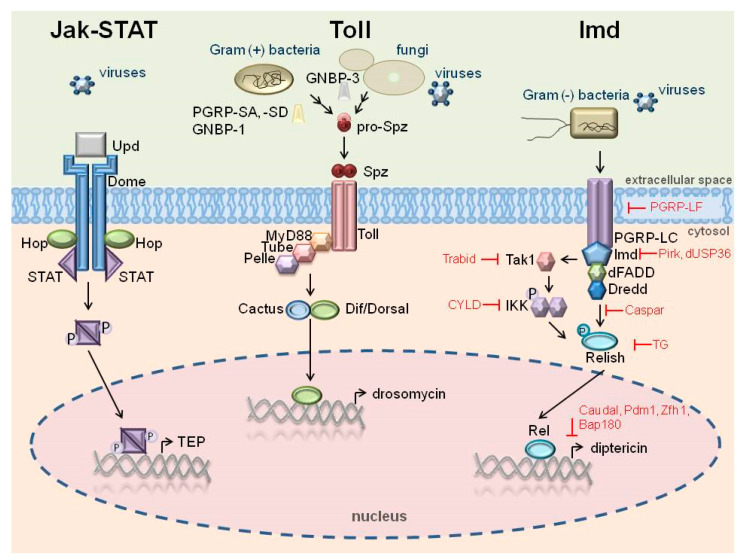Figure 1.
Main signaling pathways involved in AMP gene regulation in response to infection (simplified scheme). The Jak-STAT (Janus kinase/signal transducers and activators of transcription) pathway is induced by septic injury/damage signals or bacterial or viral infection through binding of Upd (Unpaired) cytokine to the receptor Dome (Domeless). Next, Hop (Jak kinase Hopscotch) phosphorylates Dome and STAT (Stat92E) bound to the receptor. STAT disconnects, dimerizes, and translocates into the nucleus, where it induces gene expression, e.g., TEP. The Toll pathway is activated by binding the ligand Spz (Spaetzle), which is formed from pro-Spaetzle by SPE (Spaetzle-processing enzyme) cleavage when extracellular recognition receptors PGRP-SA, -SD, and GNBP-1 recognize Gram-positive bacteria (Lys-type PGN) or GNBP-3 recognizes fungi (β-1,3-glucan), as well as after recognizing viral infection. The activated Toll receptor (dimer) binds the adaptor protein MyD88, which recruits Tube and the kinase Pelle to form a MyD88-Tube-Pelle complex. Pelle phosphorylates Cactus (IκB) leading to its degradation. Dorsal/Dif transcription factors released from the complex with Cactus translocate into the nucleus, where they activate the expression of AMPs. The Imd pathway is activated by transmembrane PGRP-LC receptors after recognition of Gram-negative bacteria (DAP-type PG). An adaptor protein Imd interacts with dFADD (Drosophila Fas-associated death domain) and Dredd (Death related ced-3/Nedd2-like caspase). Activated Tak1 kinase (TGF-beta activated kinase 1) activates IKK. The NFκB factor Relish is phosphorylated by active IKK and cleaved by Dredd to release the Rel-68 domain, which translocates into the nucleus to activate transcription of target genes. Negative regulators of the Imd pathway are indicated by  . The Imd pathway can also be activated by viruses.
. The Imd pathway can also be activated by viruses.

